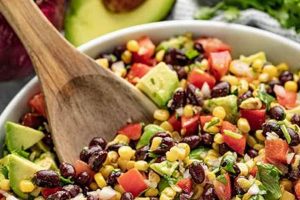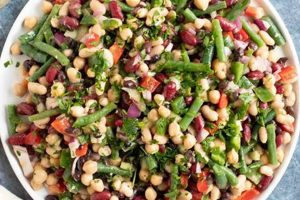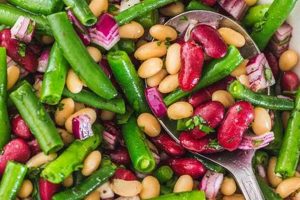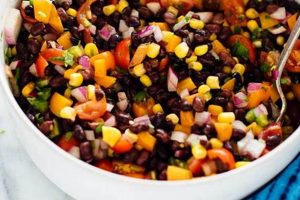A dish composed of various beans soaked in a flavorful liquid, typically a vinaigrette, often featuring complementary ingredients such as herbs, vegetables, or spices. A simple version might include kidney beans, chickpeas, and black beans marinated in a lemon-herb dressing, while more complex iterations could incorporate roasted red peppers, artichoke hearts, or feta cheese.
This culinary approach offers several advantages. The marinade not only infuses the beans with flavor but also tenderizes them over time. This makes them a convenient make-ahead dish, ideal for potlucks, picnics, or meal prepping. Furthermore, the versatility of this dish allows for endless customization based on personal preference and seasonal availability of ingredients. From light and refreshing summer variations to heartier compositions featuring autumnal vegetables, these preparations offer a nutritious and flavorful contribution to any meal.
The following sections will delve into specific aspects of crafting these salads, exploring ingredient selection, marinade variations, and techniques for achieving optimal flavor and texture. From classic combinations to innovative flavor profiles, guidance will be provided to inspire culinary creativity and ensure delicious results.
Tips for Creating Exceptional Bean Salads
Optimizing flavor and texture requires attention to detail throughout the preparation process. The following tips offer guidance for achieving superior results.
Tip 1: Bean Selection and Preparation: Dried beans offer superior flavor and texture. Soaking them overnight and cooking them until tender but not mushy is crucial. Canned beans can be used for convenience, but rinsing them thoroughly removes excess starch and sodium.
Tip 2: Marinade Composition: A balanced marinade is essential. Acidity, such as vinegar or citrus juice, adds brightness, while oil provides richness. Consider incorporating herbs, spices, garlic, or shallots for depth of flavor.
Tip 3: Marination Time: Flavor development requires time. Allowing the beans to marinate for at least two hours, or preferably overnight, allows the flavors to meld and the beans to absorb the marinade.
Tip 4: Complementary Ingredients: Consider adding other vegetables, such as diced bell peppers, red onion, or chopped celery, for added texture and flavor. Fresh herbs, crumbled cheese, or toasted nuts can also enhance the overall composition.
Tip 5: Balancing Flavors: Taste and adjust the marinade as needed. If it’s too acidic, add a touch of sweetness. If it lacks salt, add a pinch or two. The goal is a harmonious balance of flavors.
Tip 6: Serving Temperature: While these salads can be enjoyed chilled, serving them slightly below room temperature often enhances the flavor profile.
Tip 7: Storage: Proper storage ensures food safety and quality. Store leftovers in an airtight container in the refrigerator for up to three days.
By adhering to these guidelines, one can create flavorful and satisfying preparations suitable for a variety of occasions.
Through careful consideration of ingredients, marinades, and complementary components, culinary creations that delight the palate are easily achievable.
1. Bean Variety
Bean selection significantly influences the final character of a marinated bean salad. Different beans offer unique flavor profiles, textures, and nutritional values, impacting the overall culinary experience. Careful consideration of bean variety allows for tailored flavor combinations and optimal results.
- Flavor Profiles:
Each bean variety possesses a distinct flavor. Kidney beans offer a robust, earthy taste, while black beans contribute a subtle sweetness. Cannellini beans provide a creamy, mild backdrop, allowing other flavors to shine. Choosing beans with complementary flavors enhances the complexity of the salad.
- Texture Variations:
Texture plays a crucial role in a successful salad. Some beans, like chickpeas, hold their shape well, providing a firm bite, while others, such as pinto beans, become softer when cooked. Combining beans with varying textures creates a more interesting and enjoyable mouthfeel.
- Nutritional Considerations:
Different beans offer varying nutritional benefits. Kidney beans are rich in protein and fiber, while black beans are a good source of antioxidants. Incorporating a variety of beans maximizes nutritional value and creates a more balanced meal.
- Visual Appeal:
The visual presentation of a salad enhances its appeal. Different beans offer a range of colors and sizes, adding visual interest to the dish. A mix of colorful beans, such as red kidney beans, black beans, and white cannellini beans, creates a vibrant and appetizing salad.
By strategically selecting bean varieties based on flavor, texture, nutrition, and visual appeal, one can elevate a simple marinated bean salad into a complex and satisfying culinary creation. The interplay of these factors contributes significantly to the overall enjoyment of the dish.
2. Marinade Acidity
Marinade acidity plays a crucial role in a successful bean salad recipe. The acidic component, typically vinegar or citrus juice, performs several key functions. It brightens the overall flavor profile, cutting through the richness of the beans and other ingredients. Furthermore, acidity contributes to the preservation of the salad, inhibiting bacterial growth and extending shelf life. Finally, the acid in the marinade reacts with the beans, enhancing their texture and contributing to a more pleasing mouthfeel. For instance, a red wine vinegar marinade imparts a tangy complexity to a kidney bean salad, while a lemon-herb marinade offers a refreshing lightness to a cannellini bean salad.
The specific type and amount of acid used influence the final outcome. Different vinegars, such as red wine vinegar, apple cider vinegar, or balsamic vinegar, impart distinct flavor nuances. Citrus juices, like lemon or lime, offer a brighter, more citrusy note. Balancing the acidity level is crucial; too much acid can overpower the other flavors, while too little may result in a bland salad. The desired acidity level also depends on the other ingredients in the salad. A salad with robust flavors, such as roasted vegetables or strong cheeses, can handle a higher level of acidity, while a more delicate salad may benefit from a milder acid component. Practical applications include adjusting acidity based on personal preference or the overall flavor profile of the salad.
Understanding the function and impact of marinade acidity allows for greater control over the final product. Careful selection and balancing of the acidic component contribute significantly to the overall flavor, texture, and preservation of the bean salad. This knowledge empowers one to create tailored marinades that complement the chosen ingredients and achieve the desired culinary outcome. Challenges may arise from ingredient interactions or achieving the ideal balance, but experimentation and mindful tasting guide the process. The interplay of acidity with other marinade components, such as oil, herbs, and spices, further shapes the flavor profile and should be considered in recipe development.
3. Marination Time
Marination time represents a critical factor in developing flavor and texture within a marinated bean salad. The duration of marination directly influences the degree to which the marinade penetrates the beans, impacting both taste and mouthfeel. Understanding the relationship between marination time and the final product is essential for achieving desired results.
- Flavor Infusion
The primary purpose of marination is flavor infusion. As beans rest in the marinade, they absorb its componentsacids, oils, herbs, and spices. Longer marination times generally lead to more pronounced and complex flavors. A brief marination, perhaps an hour or two, imparts a subtle hint of the marinade, while an overnight soak allows for a deeper, more thorough infusion. The specific flavors of the marinade also influence the optimal marination time; delicate herbs may require less time than robust spices to achieve the desired intensity.
- Texture Modification
Beyond flavor, marination time affects bean texture. The acid in the marinade interacts with the beans’ cell walls, leading to subtle changes in firmness. Shorter marinades retain a firmer texture, while extended marinades can result in a softer, more yielding bean. This texture modification can be advantageous or detrimental depending on the desired outcome and the specific bean variety. For instance, a firmer bean may be preferred in a salad with crisp vegetables, while a softer bean may complement a creamier dressing.
- Food Safety Considerations
While longer marination times generally enhance flavor and modify texture, food safety considerations must be taken into account. Acidic marinades inhibit bacterial growth, but prolonged marination at room temperature can still pose risks. Refrigeration is crucial for safe extended marinades. The specific ingredients and ambient temperature influence safe marination practices. Highly acidic marinades and cooler temperatures permit longer marination times, while less acidic marinades and warmer temperatures necessitate shorter durations or constant refrigeration.
- Practical Application and Adjustments
In practice, optimal marination time depends on a combination of factors, including the specific recipe, desired flavor intensity, bean variety, and ambient temperature. Recipes often provide suggested marination times, but these should be viewed as guidelines rather than strict rules. Adjustments may be necessary based on personal preference or specific circumstances. Tasting the beans periodically during marination allows for assessment and adjustment of the timeline, ensuring the desired flavor and texture are achieved.
The interplay between marination time and the resultant bean salad’s characteristics demonstrates the importance of this often-overlooked element. By understanding the factors influencing marination effectiveness and considering the desired flavor profile and texture, one can achieve consistently delicious and satisfying results. Balancing flavor development, texture modification, and food safety considerations ensures a successful outcome, transforming a simple bean salad into a culinary masterpiece.
4. Complementary Flavors
Complementary flavors represent a crucial element in crafting a well-balanced and flavorful marinated bean salad. The inherent simplicity of beans necessitates thoughtful consideration of additional ingredients to elevate the dish beyond basic fare. These complementary flavors interact with the beans and the marinade, creating a complex and harmonious taste profile. This interplay of flavors transforms a simple bean salad into a more sophisticated and satisfying culinary experience. For instance, the earthiness of kidney beans pairs well with the bright acidity of red onion and the herbaceous notes of parsley, while the subtle sweetness of black beans complements the smoky flavor of roasted red peppers and the tang of lime juice. The selection of complementary flavors should consider the specific beans used, the marinade profile, and the desired overall taste.
Ingredient pairings provide a practical framework for understanding complementary flavors. The goal is to create a balance of tastessweet, sour, salty, bitter, and umamithat enhance rather than compete with each other. Herbs, spices, vegetables, fruits, and even cheeses can contribute complementary flavors. Fresh herbs like dill, mint, or cilantro add brightness and complexity. Spices such as cumin, coriander, or chili flakes introduce warmth and depth. Vegetables like bell peppers, red onion, or corn offer sweetness and texture. Fruits like chopped apples or dried cranberries provide a contrasting sweetness and tartness. Crumbled feta cheese or toasted nuts contribute salty and savory notes. The possibilities are extensive, limited only by culinary imagination and the desire for balanced flavors. For example, a Mediterranean-inspired bean salad might feature chickpeas, Kalamata olives, crumbled feta cheese, and a lemon-herb vinaigrette. The saltiness of the olives and feta complements the creamy chickpeas and tangy marinade, creating a harmonious and flavorful dish.
Mastery of complementary flavors in marinated bean salads involves understanding the interplay of ingredients and the impact of specific flavor combinations. Challenges include balancing contrasting flavors without creating clashes and avoiding overpowering any single element. The ultimate objective is to create a synergistic blend where each ingredient contributes to the overall harmony of the dish. This understanding allows for greater creativity and control in recipe development, leading to consistently delicious and satisfying results. Building a flavor profile involves considering the base flavors of the beans, the acidity and other components of the marinade, and the individual contributions of each complementary ingredient. This holistic approach ensures a cohesive and well-rounded final product, elevating the humble bean salad to a culinary creation worthy of appreciation.
5. Texture Variation
Texture variation contributes significantly to the enjoyment of a marinated bean salad. A monotonous texture can render even the most flavorful salad unappealing. Contrasting textures create a more dynamic and satisfying sensory experience. The interplay of soft, firm, crunchy, and creamy elements elevates the salad from simple sustenance to a culinary delight. This textural diversity keeps the palate engaged and adds a dimension of complexity often overlooked in simpler preparations. Consider a classic three-bean salad: the soft texture of cooked beans contrasts with the crisp snap of diced celery and the pungent bite of red onion, creating a balanced and engaging mouthfeel. This interplay of textures enhances the overall enjoyment of the salad.
Several techniques can introduce textural variation. Incorporating crunchy vegetables, such as diced bell peppers, cucumbers, or carrots, provides a refreshing counterpoint to the softer beans. Adding toasted nuts or seeds introduces a satisfying crunch and nutty flavor. Crumbled cheese, such as feta or goat cheese, contributes a creamy element that contrasts with the other textures. Even the beans themselves can offer textural diversity. Using a variety of beanskidney, black, cannellini, for exampleintroduces subtle differences in firmness and size, enhancing the overall textural profile. The choice of ingredients and preparation methods directly influences the final textural outcome. For example, roasting vegetables before adding them to the salad creates a slightly charred, smoky flavor and a softer texture, distinct from the raw crunch of fresh vegetables. These seemingly minor details significantly impact the overall dining experience.
Understanding the impact of texture variation allows for greater control over the final product. Careful consideration of ingredient selection and preparation methods ensures a balanced and engaging textural profile. Challenges may arise from balancing contrasting textures without creating an overly complex or disjointed mouthfeel. Overly soft or mushy textures should be avoided, as they can detract from the overall enjoyment. The goal is to create a harmonious blend of textures that complement the flavors of the marinade and other ingredients. This attention to detail elevates the marinated bean salad from a simple side dish to a more sophisticated and satisfying culinary creation.
6. Presentation
Presentation plays a significant role in the overall perception and enjoyment of a marinated bean salad. While flavor and texture are paramount, visual appeal elevates the dish from a simple side to a more enticing culinary creation. Consideration of color, arrangement, and serving vessel enhances the dining experience, making the salad more appetizing and inviting. Effective presentation communicates care and attention to detail, transforming a basic recipe into a thoughtfully composed dish.
- Color Palette
A vibrant and varied color palette enhances visual appeal. The natural colors of different beansthe deep red of kidney beans, the jet black of black beans, the creamy white of cannellini beansprovide a foundation. These can be complemented by the addition of colorful vegetables, such as bright red bell peppers, deep green cucumbers, or vibrant yellow corn. Fresh herbs, like emerald parsley or vibrant cilantro, add further pops of color. A well-composed color palette stimulates the appetite and creates a visually engaging dish. For example, a salad featuring a mix of red, black, and white beans, combined with chopped red onion, green bell pepper, and orange carrots, offers a vibrant and appealing presentation.
- Arrangement and Composition
Thoughtful arrangement enhances the presentation. Simply tossing all ingredients together can result in a visually uninspired dish. Consider layering ingredients or arranging them in distinct sections to create visual interest. A bed of mixed greens can provide a foundation for the bean salad, adding height and visual appeal. Garnishing with fresh herbs or a sprinkle of toasted nuts or seeds adds a finishing touch. A well-composed salad demonstrates care and attention to detail, elevating the overall dining experience. For instance, arranging the beans and vegetables in concentric circles or distinct rows creates a more visually appealing presentation than a simple homogenous mixture.
- Serving Vessel
The choice of serving vessel contributes to the overall presentation. A clear glass bowl showcases the vibrant colors and textures of the salad. A rustic wooden bowl adds a touch of warmth and earthiness. Individual serving dishes create a more formal presentation. The serving vessel should complement the style of the salad and the occasion. For example, a clear glass bowl allows the vibrant colors of a Mediterranean-inspired bean salad to shine through, while a rustic wooden bowl complements a more hearty, autumnal bean salad. The choice of serving vessel should be deliberate and contribute to the overall visual appeal.
- Garnishes and Finishing Touches
Garnishes provide the final flourish, elevating the presentation from simple to sophisticated. A sprinkle of fresh herbs, such as chopped parsley, cilantro, or chives, adds a touch of freshness and color. Toasted nuts or seeds contribute texture and visual interest. A drizzle of olive oil or a sprinkle of crumbled cheese adds a touch of richness. Garnishes should complement the flavors of the salad and enhance its visual appeal. For example, a sprinkle of toasted slivered almonds complements a salad with a lemon-herb vinaigrette, while a drizzle of balsamic glaze adds a touch of sweetness and visual contrast to a salad with roasted vegetables.
By considering these elements of presentationcolor palette, arrangement, serving vessel, and garnishesone can transform a simple marinated bean salad into a visually stunning and more enjoyable culinary experience. These seemingly small details communicate care and attention, elevating the perceived value of the dish and enhancing the overall dining experience. Thoughtful presentation complements the flavors and textures of the salad, creating a harmonious and satisfying sensory experience.
Frequently Asked Questions
This section addresses common inquiries regarding marinated bean salads, providing concise and informative responses to facilitate successful preparation and enjoyment.
Question 1: What types of beans are best suited for marinated salads?
While most beans can be utilized, firmer varieties such as kidney, black, pinto, and chickpeas hold their shape well during marination. Softer beans, like cannellini or Great Northern, can also be used but may require shorter marination times to prevent excessive softening.
Question 2: How long should a bean salad marinate?
Optimal marination time ranges from two hours to overnight, allowing for adequate flavor infusion. Refrigeration is essential for food safety during extended marination periods. Over-marination can lead to excessive softening, particularly with softer bean varieties.
Question 3: Can canned beans be used in marinated salads?
Canned beans offer convenience. Thorough rinsing removes excess starch and sodium. However, dried beans, properly cooked, generally offer superior flavor and texture.
Question 4: What are common marinade ingredients?
Typical marinades incorporate an acidic component (vinegar or citrus juice), oil, herbs, spices, and aromatics like garlic or shallots. The specific combination of these ingredients determines the final flavor profile.
Question 5: How should marinated bean salad be stored?
Storage in an airtight container in the refrigerator preserves the salad for up to three days. Quality may degrade over time, however, as the marinade continues to interact with the ingredients.
Question 6: Can marinated bean salads be frozen?
Freezing is generally not recommended, as it can negatively impact the texture of the beans, rendering them mushy upon thawing. Freezing also affects the overall flavor profile and consistency of the marinade.
Careful attention to bean selection, marinade composition, and marination time ensures a successful and flavorful outcome. Understanding these factors allows for adaptation and customization based on individual preferences and dietary needs.
The following section offers a collection of curated marinated bean salad recipes, showcasing diverse flavor combinations and ingredient pairings.
Marinated Bean Salad Recipe
Exploration of marinated bean salad recipes reveals a dish offering considerable culinary potential. Careful selection of bean varieties, thoughtful marinade composition, and attention to complementary flavors and textures are critical for achieving optimal results. Marination time influences both flavor infusion and textural development, necessitating careful consideration. Presentation elevates the dish, transforming simple ingredients into a visually appealing and satisfying culinary creation. Addressing common inquiries regarding ingredient selection, preparation techniques, and storage further empowers culinary exploration.
Marinated bean salads represent more than a mere combination of ingredients; they embody a versatile and adaptable culinary concept. Potential for creativity within this framework remains vast, inviting further exploration of flavor profiles, textural combinations, and presentation techniques. This adaptable dish offers a canvas for culinary expression, promising continued evolution and enjoyment within the culinary landscape.






